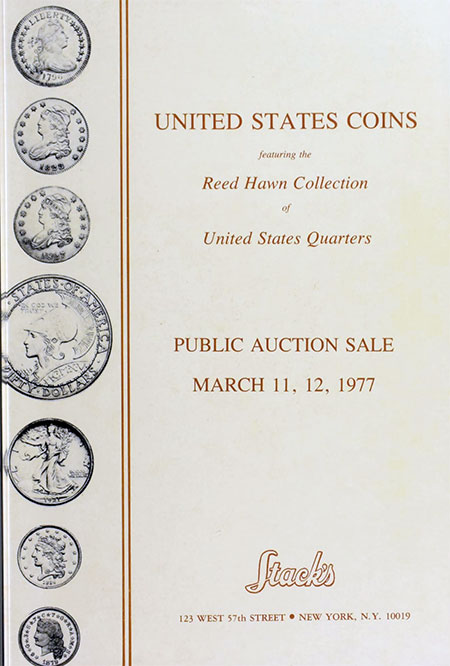
By Harvey Stack – Co-Founder, Stack’s Bowers Galleries ……
After having a very successful year in 1976, the market seemed to want to keep growing in 1977. There was a bit of a slow start in January, but enthusiasm picked up not long after. Coin values were increasing, as high-quality rarities and collections entered the market via public auction.
Additionally, the United States Mint sold over three million Proof sets in 1977, so interest in new coins was still there!
The Bicentennial celebrations that highlighted the year 1976 carried through into the new year, as most exhibits were displayed for a two-year period. Both New York City and (of course) Philadelphia had numerous places to visit, and we received many visitors and collectors thanks to these virtually continuous events. Our retail shop was usually crowded that year, and our seven auctions (almost one a month in both the Spring and the Fall) were well-attended with excited bidders.
However, there was another factor at play. People felt that investing in bulk silver coins, taken from change, would lead to major profits if held long enough. Investors who played the precious metal markets began cashing in their rolls and bags of coins–dated 1964 or earlier–and made profits above face value as the precious market became lucrative. But looking at all the coins that came into their possession, some became collectors, trying to see how many different dates and mints they could find. This was a factor that helped expand our market and many a coin dealership became a location where one could buy or sell silver coins.
To help these new collectors, the American Numismatic Association (ANA) and their new grading service ANACS provided guidance as to whether a coin was genuine or counterfeit. ANACS also gave a professional opinion on the coin’s grade or whether it had been cleaned, polished, buffed, retooled or doctored in any way. Of course, the ANA charged a small fee for this service. But, since ANACS was available, more confidence returned to the market.
Nevertheless, the way this information was delivered to the collector had one major flaw.
How a Good Idea Developed a Serious Flaw
After ANACS examined a coin, it was photographed (a very good photo, in most cases), and the coin, grade opinion and photograph were thus returned to the submitter. Unfortunately, you could not attach the photo to the coin, so the validation information was separate. A number of scoundrels soon realized how to make money by the misuse of the photograph!
They would send in a beautiful Mint State coin for grading. It would come back marked (MINT STATE and maybe with a grading number). The scoundrel would take an inferior coin, one that was polished, dipped improperly, scratched or heavily nicked or marked, and sell it with the ANACS certificate at the premium price of the superior coin in the photograph. Though the pictures were good, they did not show the alterations or defects on the inferior coin. So the buyer was happy, and the scammer made a bundle. The scammer would then submit the original, superior coin again, get it graded and photographed, and repeat the con.
At a later ANA board meeting where these “scamming actions” were discussed in length, the answer they were forced to admit was that ” NO GOOD DEED GOES UNPUNISHED”. The Professional Numismatists Guild (PNG), an organization made of the best and highest group of professional numismatists, worked to stop this form of theft and were quite successful. But how many coins laid for years in the collections of fleeced buyers we will never know.
At any rate, coin certification needed better safeguards, and it wasn’t until 1982-83 when NGC and PCGS entered the field and inserted the coins they graded into plastic holders known as “slabs” to deter such scammers.
Public Auctions
Following the successful auctions Stack’s conducted in 1976, with the outstanding ANA sale as the leader, we were confronted with a number of smaller but outstanding collections that we were unable to schedule in the prior year.
Stack’s offered seven different sales in 1977 at Public Auction:
In February 1977, we offered an extensive collection of U.S. coins formed by T. Henry Allen, an old-time client of the company. The scope of the collection was large, and many attended the sale.
In May, we offered, in a single sale, more coins from the Estate of Henry Allen, together with the collections of William H. Fenn and Harry Prock. These collections complimented each other and gave the general collector a chance to own choice and rare coins in various grades.
In June we had a general public auction, from Colonial Coins through the $20.00 gold, that again offered attractive coins for all collectors to consider. We included an interesting offering of Foreign Gold and Silver to serve those collectors of world coinage.
In September, we featured the Donald J. Davenport collection of U.S. Coins. Mr. Davenport started collecting U.S. issues, but later worked on the Dollars of the World (about which he wrote several reference books). He used the funds from this auction to enhance his world coin collection.
 Then in October, we offered for sale one of the most outstanding collections, formed by Charles Z. Mihaili of Hungarian and Transylvanian coins in Silver and Gold, which was known as one the most complete offerings of its type formed in the United States. His collection’s auction catalog is still used as a reference today.
Then in October, we offered for sale one of the most outstanding collections, formed by Charles Z. Mihaili of Hungarian and Transylvanian coins in Silver and Gold, which was known as one the most complete offerings of its type formed in the United States. His collection’s auction catalog is still used as a reference today.
In December 1977, we gathered together a series of small consignors of scarce and rare coins, mostly in high-grade circulated condition or Mint State.
The Reed Hawn Collection of Quarters
In March, we were given a superb collection formed by Reed Hawn, who had been collecting since the early 1950s when he and his father first visited Stack’s and dedicated himself to the U.S. quarter series. Stack’s was fortunate to be able to serve such a dedicated collector for over 20 years.
Reed Hawn’s Collection of Quarters, 1796 to 1976, was one of the finest and relatively complete choice collections of the series, with but a few others that ever attained this status in sales. Many of the highlights included (in Proof and Mint State) pedigree examples of 1796; 1804; 1815; 1819; 1823/2; the 1827 Original and the 1827 Restrike; 1831-1852; virtually all the Proofs from 1853 to 1891, and Mint States of the various mint marks also struck; and complete Barber and Liberty Standing issues from 1892 to 1930 in Proof and Mint State. Each coin sold has since become valued for this famous pedigree. Hawn used the funds from this auction to work on other series with the same enthusiasm, and Stack’s was privileged to sell them later in the century on his behalf.
* * *
Links to Earlier Parts:
1928-35 | 1935-45 | 1945-51 | 1951-52 | 1954 | 1955-56 | 1957 | 1958-59 | 1960 | 1961-62 | 1963 | 1964 | 1965 | 1966 | 1967 | 1968-69 | 1970-71 | 1972 | 1973 | 1974 | 1975 | 1976




